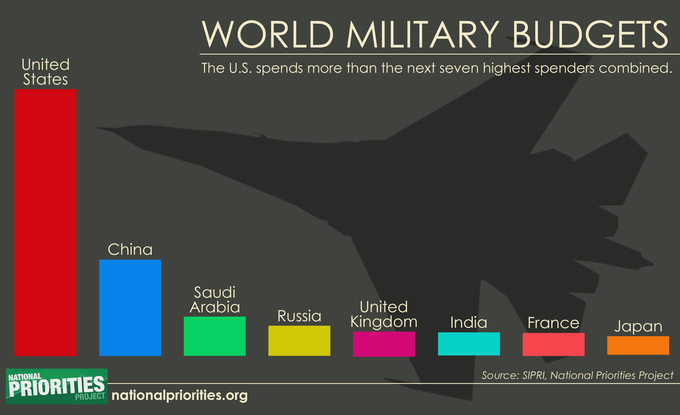Let me ask you a question. Assume you are the largest and most powerful company in a specific market sector. You have been outspending the competition for years. Much of that investment has been spent on technology, new equipment that was supposed to give you an even greater edge against the competition. But instead of higher profits, you are losing customers. The competition has increased investment but not nearly at the rate you have. And they are establishing footholds in markets which were thought to be your anchors. In other words, the return on investment (ROI) was not what one would expect. What would you do?
As I’ve written on several occasions, I wish those who constantly advocate running the government like a business would use the metrics employed by the private sector to make spending decisions. Ask any CEO, “Would you continue to investment in the same factors of productions if your record of success over 70 years was less than stellar?” Of course not. Yet, that is exactly what Donald Trump and GOP Congress tell us is at the heart of the upcoming vote on a continuing resolution to keep the federal government open.
On Tuesday morning, the flipflopper-in-chief tweeted, “The Democrats want to shut down the Government over Amnesty for all and Border Security. The biggest loser will be our rapidly rebuilding Military, at a time we need it more than ever.” On Monday, it was reported, “The Pentagon is planning to develop two new sea-based nuclear weapons to respond to Russia and China’s growing military capabilities, according to a sweeping Defense Department review of nuclear strategy. (Wall Street Journal, January 15, 2018)” The proposed White House defense budget for FY2018 is $647 billion, a 5.4 percent increases from FY2017. (NOTE: This does not include an additional $183.5 billion for veterans benefits and $88.9 billion for amortization of unfunded liabilities.) According to the Center for Strategic & International Studies, “The request includes $21.8 billion for atomic energy defense activities to maintain the nation’s arsenal of nuclear warheads and bombs.”
 In the last year for which data is available, the total global military spending was $1.6 trillion in 2015, of which the U.S. share was 37 percent (Source: National Priorities Project). U.S. expenditures eclipsed the total of the next seven nations and was 277 percent higher than the that of China which ranked #2. With that kind of advantage, one would think the United States would be cleaning the competition’s clock. But, let’s look at the ROI from this massive investment.
In the last year for which data is available, the total global military spending was $1.6 trillion in 2015, of which the U.S. share was 37 percent (Source: National Priorities Project). U.S. expenditures eclipsed the total of the next seven nations and was 277 percent higher than the that of China which ranked #2. With that kind of advantage, one would think the United States would be cleaning the competition’s clock. But, let’s look at the ROI from this massive investment.
- Despite a three-year war (oops, police action), Korea remains divided and the North now has nuclear weapon capacity, something that every administration for four decades has vowed they would never have.
- An American supported invasion at the Cuban Bay of Pigs in 1961 to overthrow the Castro regime resulted in the Castro brothers continuing to lead the country 56 years later.
- After military engagement in Vietnam from March 8, 1965 to April 30, 1975 and the loss of over 54,000 American soldiers, today a unified Vietnam under communist rule is both politically and economically stable.
- After 16 years in Afghanistan, the Taliban remains an insurgent force. Even MOAB (the mother of all bombs) has not deterred the Taliban and ISIS in the region.
- Thirteen years in Iraq is best described as an ebb and flow between somewhat friendly and highly unfriendly forces. The recent double suicide bombings in Baghdad suggests that despite the overwhelming U.S. military power availability to the Masum government, Iraqis live in fear of continued ISIS insurgency.
- Formal and informal branches of global jihad are an increasing threat worldwide, not shrinking.
I know, you might argue we are facing a different kind of military threat. Insurgent forces organized in cells is different from conventional forces operating under national flags. Absolutely correct. And that’s my point. Trump and the GOP Congress still think we are Kodak and FotoMat, wondering why nobody is buying 35 millimeter film or bringing undeveloped rolls to our kiosks to process. They have proposed a defense budget which suggests the problem is not enough FotoMat store fronts or an under-supply of negative and chemical-based photographic supplies.
Nothing is absolute. I know there are units within the Pentagon who are focused on non-traditional responses to the real threats we face. Cyber-security and counter-intelligence resources have increased. For FY2017, the Obama administration asked for a 15 percent increase for cyber-security operations raising the expenditure level to $6.7 billion. Compare that to the $122 billion in the Trump budget for procurement of NEW weapons systems. I guess, little boys do love their shiny toys.
For what it’s worth.
Dr. ESP
We lost America in middle school.
The thinking behind the buildup must be that if we’re aiming to shoot, don’t go halfway. Are we aiming to shoot? Also, everyone knows the maginot line would have held IF it was funded beyond what it was, and that Napoleon would have probably won at Moscow and certainly at Waterloo IF he had a sufficient number of horses.